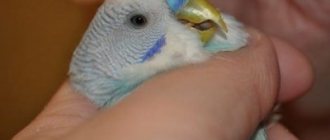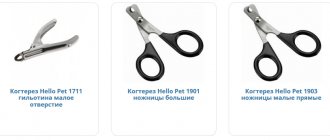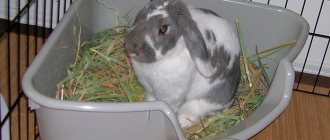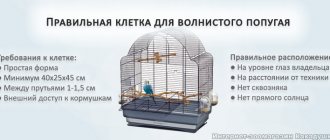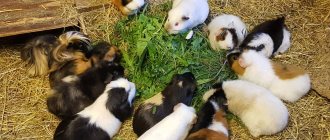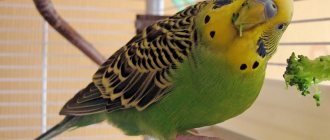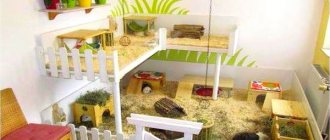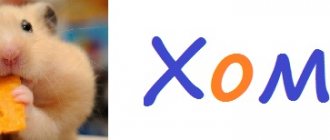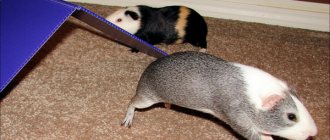- home
- Parrot
- Arrangement
05/23/2019 Parrots bring joy and comfort to your home. In order for a feathered pet to feel good, it needs to equip its home. Feeders and waterers are not all accessories for parrots. There are a lot of useful attributes that a cage can be equipped with. Everything needs to be taken care of in advance so that the bird feels comfortable from the first days and willingly makes contact with humans.
Dwelling size
For budgies
Miniature birds in a cramped cage will not feel comfortable, especially if the pet is not alone there. Restriction in movement will not lead to good things. Obesity can even occur, which is very dangerous for the health of children, whom nature ordered to be playful and active.
Cages for budgies
For the cockatiel
This parrot needs to have a rectangular house, without domes, and there should be no enamel in the decoration. But the more exits and entrances, the better. It will cost a pretty penny, but the convenience for the bird is worth any expense. In addition, the cage needs to be long, at least sixty centimeters for a single person. The width is forty-five and the same height.
Choosing a cage for a cockatiel
For a couple, the length should be up to a meter. Corella likes to fly horizontally, two or three beats of its wings inside the cage should be obtained. The rods on the walls are arranged in the same way - parrots climb on them, but with vertical rods this is impossible. Clearances in the lattice of more than three centimeters are not needed; the feathered climber will need to take too wide steps.
Read also
Why did the parrot become aggressive and bite?
For Grays
For large birds, the house must be spacious. In industry, those responsible for assortment, unfortunately, do not listen to the needs of breeders. The maximum cell sizes that are commercially available are 65x45x80.
Gray cages
Even for one Gray this area is not enough, but there is nothing to choose from. This parrot has high intelligence and an exceptionally powerful beak. Combined, you get a vandal!
Therefore, the rods must be strong and durable, the feeders must be secured, and the doors must close securely. The gray latch opens a regular latch much faster than the owner closes it. And an even more important condition: choose a cage equipped with protection against debris.
For lovebirds
- If a bird can spread its wings inside to the limit, it has the right home.
Basic parameters of a cage for lovebirds - The shape is preferably rectangular. In the round parrots cease to correctly navigate in space. The roof can be anything - flat or domed.
- A plastic bottom and a chrome-plated metal top is the best option. Lovebirds chew up the tree. You can’t make it from copper, it oxidizes and is poison for any birds.
- It is better to place it near the wall, so the pets feel protected. Choose the height at eye level. It's good to have a special stand. There should be no drafts in this place, and no heating radiators nearby. The accommodation is stationary; any relocation causes a commotion among the small birds.
- Lovebirds are curious and try to get into everything. Therefore, a distance of about one and a half centimeters between the bars will prevent the baby from getting injured when trying to dive into the gap.
- The most convenient is a pull-out tray made of iron or aluminum.
For cockatoos
The parameters are the same as for the Gray parrot and other large parrots.
Choosing a cage for a cockatoo
Perches for budgies
A standard cage for one budgie can usually accommodate two or three perches. It is worth fixing them at different levels, and the top one should be at a comfortable distance from the ceiling, since this is what the bird will choose as a sleeping place. When placing, keep in mind that the lower pole should not be directly under the top one, otherwise the pet will constantly dirty it. It is better to place the perches at a vertical and horizontal distance from the bird, so that it can easily flutter between them and stretch its wings.
According to their purpose, perches can be basic or specialized, as well as artificial and made from natural materials. Basic perches are used for permanent residence of the parrot, while specialized ones are usually needed for grinding down the beak and claws, heating, quarantine, and other things.
Typically, the following types of perches are installed in the cages of budgies:
1. Plastic. These are temporary, sometimes hollow inside, additives that are often included in cages for sale. They are well suited for organizing quarantine because they are easy to sterilize and disinfect, wash well and do not accumulate detergents. But with prolonged use, problems arise: the birds do not grind down their claws, rub calluses on their paws, overwork their muscles, which leads to early diseases of the musculoskeletal system and falls from the perch. They can also be a source of parasitic infestation.
2. Flexible (including rubberized). Modular structures are also made of plastic and have corresponding disadvantages. Sometimes on sale you can find perches covered with rubber, but most parrots deal with it without difficulty. Modular perches help change the “interior” of the cage, allow you to organize space for several birds and provide them with access to important objects (feeders, drinkers, toys) without unnecessary clutter in the house.
3. Industrial wood. Such perches are equipped with a reliable fastening using a nut or a longitudinal cutout and are made of harmless material. A large selection of diameters and textures allows you to provide your parrot with an optimal set of attachments. But remember that smooth polished poles increase the load on certain areas of the foot - it is better to choose uneven poles or at least options with a rhombic cross-section.
4. Filamentous. Typically, in the center of such products there is a wire, thanks to which their shape can be changed. The outside is lined with cotton cord. Unfortunately, parrots love to fray such poles, mistaking them for toys. If birds become entangled in threads with their beaks or claws, they can be seriously injured or even die.
5. Cement, volcanic or sand-coated. These attachments are intended exclusively for grinding down the beak and claws and help avoid the unpleasant manipulations of trimming them. All you need in a cage is this kind of perch, and it should be located at the lower levels, otherwise the bird’s paws will be constantly irritated.
6. Heated. Such devices are rare in apartments and are more popular in enclosures. It is risky to buy them for a pet parrot - with a high probability the bird will destroy the insulation and get to the conductive elements.
7. Natural wood. Currently the most popular, useful and cheapest option. Tree bark contains fiber, cellulose, some micro- and macroelements, serves as a valuable enterosorbent, and can also keep your pet occupied for a long time. In nature, budgies often eat bark, even when there is an abundance of other food, as feeding, and use it to grind down their beaks.
Branches should be harvested away from the roadway and sources of pollution - in forests, remote parks, botanical gardens, and dachas. However, many wild birds live in these places, so natural perches need pre-treatment. Do not cut branches treated with pesticides or other chemicals! Select a branch with a diameter of 1.2 to 1.8 cm, free of mosses, lichens, woodworms and other tree diseases, so that the planting does not cause fungal or bacterial disease. Then rinse it thoroughly, pour boiling water over it or bake it in the oven (the thicker the branch, the longer the procedure) and dry for 24 hours.
Your pet will certainly appreciate a perch made from branches of fruit trees and shrubs (apple tree, cherry, plum, apricot, viburnum, rowan, hawthorn, currant, raspberry, citrus), as well as from aspen, ash, birch, willow, alder, maple, linden, hornbeam, beech. Under no circumstances should you make a perch from oak, pear, bird cherry, poplar, lilac, elderberry, or acacia wood.
The optimal thickness of the perch is determined as follows: the bird should grasp it 2/3 or 3/4, while touching the perch with its claws. A pole that is too thin will result in overgrown nails, while a pole that is too thick will tire the paws. Preferable attachments are of different thicknesses, which are replaced as the bark is nibbled.
Where is the best place to place the cage?
The place should be as well lit as possible, although direct sunlight is unacceptable, as it is extremely harmful to all breeds of parrots. We need to remind you about drafts again; they most often lead to the death of southern beauties.
The air temperature must be maintained at 25 degrees; if it drops, the birds will be chilly and catch a cold. It is better not to have birds at all in a damp room.
Where should you place a parrot cage?
All pets love communication, without which they get bored and sad. Their habitat must be chosen according to this feature: in the room where people relax, in the dining room or living room. However, the cage should not interfere with anyone.
It is better to place it away from the door: I can remember any number of tragic cases when a little wavy did not have time to follow its owner, the door closed and injured him. Igor Ignatenkov
Lighting
Any living creature adheres to a certain daily routine. The same goes for wavy ones. In the summer seasons, the duration of daylight should be at least 12 hours, in winter - from 10. If it is not possible to fulfill these conditions in natural ways, artificial lighting sources will come to the rescue, the choice of which will require time. It is better to seal the windows with paper in advance, since ultraviolet radiation is very dangerous for wavy birds.
Daylight.
Artificial lighting.
Parrots are quite conservative in their daily routine - they need rest from nine in the evening to nine in the morning, but few people can rest as much as budgerigars. Due to insufficient sleep, birds get sick more often, become less active, and can become depressed and nervous. To avoid such problems, you need to buy lightproof fabric in advance and cover the bird’s cage at night. This will help the pet fall asleep faster and also protect the owner from cheerful chirping in the morning.
Feeders and drinkers
A pet needs different types of food: soft, mineral and grain. And that’s not all: you need to separately add charcoal, eggshells, and river sand, which are necessary for the normal functioning of the digestive system.
Read also
How to name a boy's budgerigar list of names
It is impossible to put all this in one bowl. For food, three containers are usually purchased and installed at once. They must be made of stainless steel and of suitable size. So are drinking bowls.
The optimal choice of bird house
The bird must have a cage of optimal size and shape. Pet stores sell products that can satisfy the wishes of any customer. Cells differ in shape, size and internal structure. But not all such models are safe and easy to use.
When choosing a cage, it is recommended to focus on the following parameters:
Form. Experienced ornithologists recommend buying rectangular cages for wavy birds. Angles have a positive effect on the bird’s psyche, as it feels safe. It is advisable to place one side of the cage against the wall, which will allow the pet to relax and calm down if necessary. A round structure is not suitable for wavy birds, as it creates the illusion of space, but it is inconvenient for the bird to climb curved walls.- Dimensions. If you put your parrot in a cage that is too small, it will cause stress because the bird will not have enough free space to move around. This leads to shedding, apathy and decreased appetite. If a person plans to regularly let the bird out for a walk, then the height of the cage may not exceed 45 cm. But if the wavy will spend most of its life inside the cage, then a larger structure is purchased, the height of which starts from 55 cm.
- Material of manufacture . It is not recommended to buy painted or wooden cages. Wood dries out, swells and becomes moldy when exposed to water. Therefore, ideal conditions are created for the development of bacteria and parasites. Stainless steel products are considered the right choice. They should not have sharp corners, protrusions or roughness.
The cage is installed in a well-lit and warm place, but away from heating appliances and electrical devices.
Perches
Water and food should always be clean, and therefore the parrot is given a place to sit where it cannot shit in the feeder. All accessories are arranged in accordance with this principle.
Their size is very important, since clean paws are the key to health. Birds will readily peck at a perch made of wood, with a special appetite for a perch made from fruit. You need to think especially about the materials used to make accessories.
How to place a perch correctly
Which ones should not be given?
For a budgerigar, like other species of these birds, you cannot buy painted toys. Small pieces of paint can enter the stomach, thereby causing poisoning.
Also, the accessories should not have holes in which the bird could get its beak stuck. It is better if the material used to make toys is durable, otherwise the parrot will be able to crumble it.
It is worth paying attention to the presence of sharp corners. During play, your pet may get hurt on them.
Toys and mirrors
There are a lot of inexpensive Chinese consumer goods on sale, and poultry markets have also been completely conquered by them. Because of these cheap plastics we are losing our feathered pets. Parrots of all breeds chew on everything, like mongrel puppies.
And then they swallow plastic fragments and die. Owners need to check very carefully every item they decide to buy for their pet.
An excellent solution is metal bells that can be hung in a cage: ringing and fun for both people and birds. Offering mirrors is also dangerous: the beaks are strong, and the glass is fragile. If a sharp piece of glass is swallowed, you will not be able to survive. But the owner is the master, let him decide for himself.
On the question of the mirror
Contrary to the popular myth that a budgerigar will not learn to speak without a mirror, placing this accessory in a cage is unjustified. The absence of a “friend” often even stimulates the bird’s desire to communicate with the owner in his language (however, if you are the owner of a completely wild parrot, you should not impose human society on it - it is better to buy a comrade).
Placing a mirror in a cage is permissible only for those birds that understand that this is not a living relative, but just a toy. Otherwise, the wavy will try to establish contact with the reflection, but without receiving reciprocity, he will become nervous, irritable, aggressive, and feel rejected. There are cases where, mistaking a mirror for a partner, birds violently attacked the owner’s hands when trying to touch or move the toy. The same goes for toys in the shape of birds.
Occasionally, a mirror can be used to accustom a bird to a bath, new food and its owner - it is a useful tool in establishing contact. But with constant placement in a cage, neurosis and self-plucking are possible, as well as “sticking” to the reflection and lack of interest in the outside world. Also, you should not place the mirror where two or more parrots are kept together - it can become a reason for jealousy, conflicts and neglect of the real partner. When angry, the bird can seriously hurt itself on the mirror.
Tree branches
Plastic is in no way healthy for parrots. You need wooden perches; you can buy them or make them yourself from branches cut in the park. Large fragments of trees, from which a special stand for a pet is made on the wall, also look good in the apartment.
Tree branches that can be used for a parrot
Craftsmen carve swings for the cage and various toys. The branches for the perches must be of a certain thickness - enough to grip the paw by about three-quarters of the volume. Not every tree is suitable for chewing.
Leave acacia and lilac alone, which are poisonous to birds. You cannot take branches of oak, pear, or bird cherry because of the tannins they contain. Resinous conifers are also not suitable - none.
The coffee tree does not grow here, but you need to know that it is also prohibited. But poplar is widespread, which takes away all the most harmful, poisonous, and toxic things from the atmosphere. A real cleaner of the planet's territory. But parrots are not allowed to peck its branches.
Can be used:
- hawthorn;
- birch;
- cherry;
- elderberry;
- willow;
- linden;
- aspen.
Trees from which you can make perches for a parrot
Many other trees are also suitable.
Pallet
There is no need to cover the pallet with anything. It is not necessary. The plastic tray is easy to wash and no living organisms will grow on it. Sawdust, sand, specialized filler - the parrot does not need them.
In principle, you can use sawdust if you know that the tree that became the source of sawdust is from the list of permitted species. Sawdust will constantly fly away from the flapping of the wings, and the entire space around the cage will be constantly covered with them.
The use of paper is not recommended. Most likely, sooner or later your pet will start gnawing on it, and the parrot’s body is not adapted to digest paper. Frequent consumption of paper can lead to goiter diseases. You cannot use paper pages of newspapers, because the text on such pages is printed with ink that contains toxic substances.
Other fillers for the pallet cannot be used.
In general, it is better to let the pallet be empty.
The tray is washed without using any detergents with tap water every day. If you use filler, then it is changed after each wash.
The pan grid is a completely useless element. It will also have to be washed together with the tray, and your parrot may accidentally get its paw or wing pinched.
Care
You should change the water daily to clean, boiled water at room temperature. Washing dishes should be done at least three times a week. In this way, the risks of developing parasitic diseases (worms, lice, mites, protozoa, salmonella, etc.) and inflammatory processes are reduced. You need to clean your home more than once a day; the fast pet prefers to play around a lot and break toys with its beak during the day.
Trimming claws and wings
There are many reasons why nails grow quickly: multivitaminosis, liver disease. If your pet is nervous about nail trimming, you should start with one per day:
- Grab the bird’s wings tightly and carefully and place them behind your back, giving them a tight position, without applying pressure. It is better to take it with a soft towel.
- If your pet is worried, you need to talk calmly and friendly.
- Moving one finger away, use pliers (available in stores) to shorten the overgrown nail in one motion.
- Carefully observe that the remaining fingers are outside the blade area.
- After completing the procedure, the pet is treated to tasty morsels.
Wing trimming:
- Remove the bird from the cage.
- Calm down by covering your head with a light, dark cloth.
- Place it on the table.
- The assistant must hold the legs and head.
- Gently and slowly spread the wings.
- Be careful not to trim blood feathers, these include: brown, black and red.
- It is necessary to trim a row of feathers from the inside where there is a smooth transition into thickening. Leave 2-3 rows of outer rows of feathers on the wing.
